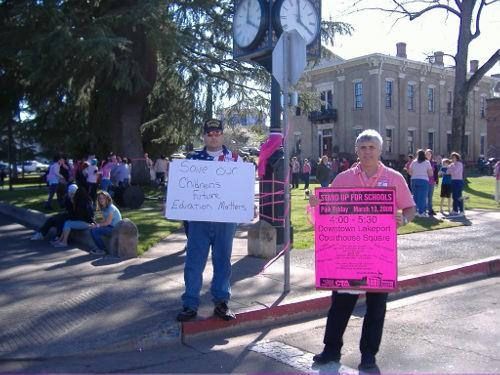LOWER LAKE – Many people – from board members to teachers to parents – had predicted that no one would be entirely happy with the decision the Konocti Unified School District Board of Trustees ultimately would make to meet address a $1.2 million budget cut in the coming fiscal year.
Those predictions proved true Wednesday night, when the board – in a 3-2 vote – directed Superintendent Dr. Bill MacDougall to close Oak Hill Middle School.
Board members Hank Montgomery and Herb Gura were the dissenting voices in the vote, which came at the end of a special four-hour meeting held in the Lower Lake High School gym, with about 100 people in attendance.
The meeting ended shortly after the vote, with board members sitting in a strained, grim-faced silence as people – some of them unhappy Oak Hill staffers and parents – filtered out of the gymnasium. Some called out angry comments to the board.
The district board has hosted nine meetings on possible consolidation measures to close the budget gap. Most of those meetings had focused on public comment, but Wednesday night was the board's first opportunity to discuss it as a body.
They came to the table having heard MacDougall's proposal – which included closing Oak Hill Middle School – at a meeting held March 4.
The board heard presentations from business manager Laurie Altic and Dana Moore, the district's director of maintenance and operations. Moore gave an in-depth description of the logistical aspects of moving students to new school facilities and how to improve schools to take on additional students.
Closing Oak Hill and moving its 473 students to other schools was part of two separate recommendations.
In the first, schools (not including the high school) would be converted to K-8, for a savings of $1,025,680, with a $265,980 cost to shift students for a net savings of $759,700. Facilities costs would amount to $475,500, but Moore said those funds are specifically for building projects, and can't be used in classrooms.
The second recommendation called for closing the school, converting Pomo Elementary to grades fourth through eighth, while Burns Valley becomes K-3, and Lower Lake and East Lake are K-8. That also would save the district $1,025,680, with $170,376 to shift students for a net savings of $855,304. Facility costs would be $510,500.
The board also voted to support continuing class size reduction measures, which MacDougall estimated would save the jobs of 13 to 15 teachers.
Board members give their perspectives
When it came time to discuss the choices – whether to close the school and realign some grades or choose another route – Montgomery was clear that he opposed Oak Hill's closure.
The proposal to close the school, he said, “has become more a referendum on Oak Hill and what it does rather than is this the best way to save money.”
Montgomery credits his children's success in college and beyond to their time at Oak Hill. “They had a tremendous experience.”
So he was troubled to hear Oak Hill become the focus of so much negative comment at the public meetings, which he said made him sad “to the very core of my existence.”
He said he's tried to think he way through closing the school, but he can't justify it. “It seems to me that closing Oak Hill is not the solution.”
Board member Carolynn Jarrett said that, based on the public hearings, she believed the relationship between school staff and parents isn't there, despite the teachers' hard work to improve the school.
Jarrett, who taught elementary school in Konocti Unified for 18 years, said for her it was a financial decision. She favored closing Oak Hill and transitioning to K-8 schools, and using the knowledge of elementary and middle school teachers to benefit students.
Said Gura, “It's such a complex decision, and anything we do affects so many other things.”
If the district didn't have its financial issues, Gura said he wouldn't even be considering closing a school. Gura said he had three children who have successfully gone through Oak Hill, with a fourth who was looking forward to the school.
He said he still many questions about the logistics of the move, and wanted to hear what the rest of the board had to say.
Board Clerk Anita Gordon, who has been on the board 10 and a half years, called the district's budget challenge “the most difficult subject matter I've ever faced sitting here in this chair.”
Gordon worked at Oak Hill for two years, and said she admired and respected the school's staff. “Teachers there are doing amazing things.”
Like Montgomery, she was saddened to hear so many negative comments made about the school in public meetings, because she knows the work the teachers and administrators are putting into the school.
But Gordon said she was thinking about the money, adding that there isn't a district in the state not having the same discussion.
The choices before the board, Gordon said, were both gut-wrenching and horrible. “They're not anything we wish to do.”
If Oak Hill was left open, that wouldn't address the looming cuts, said Gordon. They also could face the loss of students whose parents don't want them to attend Oak Hill.
Closing the school, added, Gordon, made the most sense monetarily.
Board President Mary Silva, whose four children attended Oak Hill, said it hurt to have to close the school.
“I don't know what else to do,” she said. “I don't know where else that money is going to come from.”
She said she couldn't see spending money from the district's reserves because of concerns about what the next fiscal year might bring.
“This board really has to look at all the options and make sure we're making the best choices for all the children, not just particular sites,” Silva said.
Gura asked Montgomery for his ideas – he noted he usually had good ones – on other options for how to trim the budget.
Montgomery said he had a few ideas, but none of them were big ticket items. He said they could revisit staffing ratios and take a line-by-line, surgical approach to the budget.
He said closing Oak Hill will delay the district's budget problems, not solve them. Montgomery said they needed to anticipate unintended consequences, otherwise, “We're going to wander off into the darkness.”
Montgomery asked the board to take more time to go over the budget and give the decision the time it deserved. The extra work, he said, would be nothing when compared to what it will do to the district to close one of its schools.
Silva said the district already has given out 52 pink slips to teachers, and said they'll be able to rehire teachers if the school is closed. “We're a tough district. We'll make it.”
Jarrett, referring to information Altic had provided earlier in the meeting, noted that the middle school model is expensive, more so than elementary schools. “We need to get lean.”
She said she was cautiously trying to urge the process along. “I don't think we have a lot of time for this.”
Other solutions offered
The board heard from 10 speakers, many of them speaking against closing Oak Hill.
Carle High School teacher Angela Siegel offered several options for getting through the budget crisis, agreeing with Montgomery's idea of going through the budget “surgically.”
Her suggestions included drawing small amounts from the district's reserves, saving an estimated $350,000 by not filling some positions, dropping some expensive software programs and not requiring a techie to be called every time a minor computer issue arose.
She suggested that, in the long run, it would cost more money to make the changes the district proposed.
Parent Liberty Perry said the situation was affecting a lot of lives and, whatever the decision, it was going to be hard, and no one would be completely happy with it.
“I just ask that you make this in a timely manner so these teachers that were given pink slips know what to do with their lives and their kids,” she said.
Burns Valley teacher Katherine Mullin said the process has produced a lot of anxiety for teachers and is affecting the staff at her school.
“This ongoing conversation is taking its toll. Our aides are scared to death. We have almost none left,” she said.
The sooner they know what's going to happen the better all of them can cope, said Mullin. She said her husband, who teaches in another district, also received a layoff notice.
Mullin said that every bit of energy she spends on the issue “is one little piece of me that the children of this district don't get, and they need every bit that I can offer them and they deserve it.”
The longer the district waits, she said, the less quality teachers it will be able to access, pointing out that two of the best young teachers she's seen have given their resignations and plan to leave the district.
Glen Goodman suggested the district's proposals were an expensive way to save money. Meanwhile, they still didn't know how much federal stimulus money they might receive that could help the situation. The district also could lose students and, along with them, attendance-related funding.
“It just seems to me that there's go to be a better way,” he said, urging the board not to hurry but to take the time to make the right decision.
Oak Hill Middle School teacher Tracy Lahr defended the school, and said the students haven't been asked what they want.
Oak Hill is a community, Lahr said. Closing the school isn't a win-win situation.
Another Oak Hill teacher, Paul Leiferman, said the school and its teachers take a lot of vitriol from the community. “There are those of us who are really tired of it,” he said.
Leiferman, who has taught at the school for 10 years, recalled one of his young students, a girl whose home was filled with abuse, but who – with the help of teachers – improved her grades and got onto the volleyball team.
One day she'd served some aces and went home looking forward to telling her story to a family member, only to find the man had hung himself.
“Those are the kinds of things we work through over there,” Leiferman said.
He said he wished more people knew about such stories.
Not a pleasant decision
MacDougall told the board that district staff already has gone through the budget line by line – as Montgomery had suggested they do – in order to find other cuts. If there had been a panacea, they would have used it already.
“It is not a pleasant situation whatsoever,” MacDougall said.
He said the board could direct him to go back through the budget, line by line, but he guaranteed they would arrive at the same conclusions.
Jarrett moved to direct MacDougall to close Oak Hill, with Gordon seconding. Silva joined the two in voting for the proposal, with Gura and Montgomery voting no.
E-mail Elizabeth Larson at This email address is being protected from spambots. You need JavaScript enabled to view it..
{mos_sb_discuss:3}















